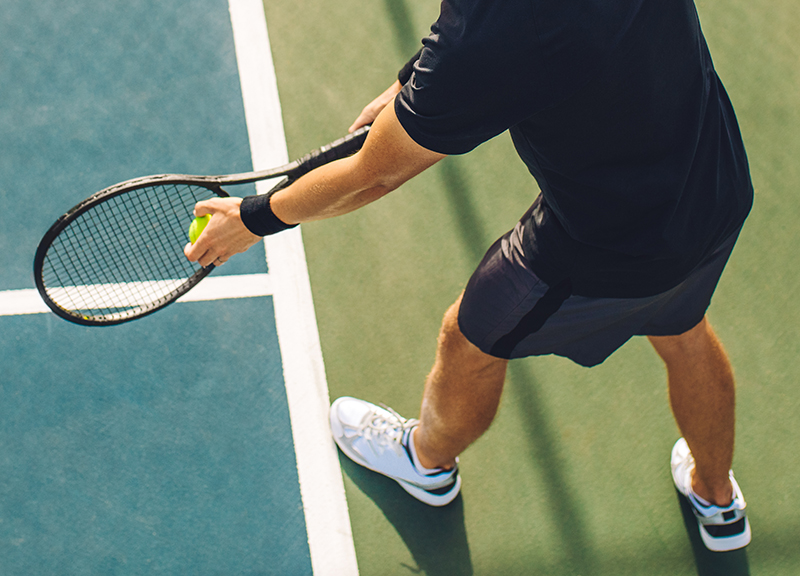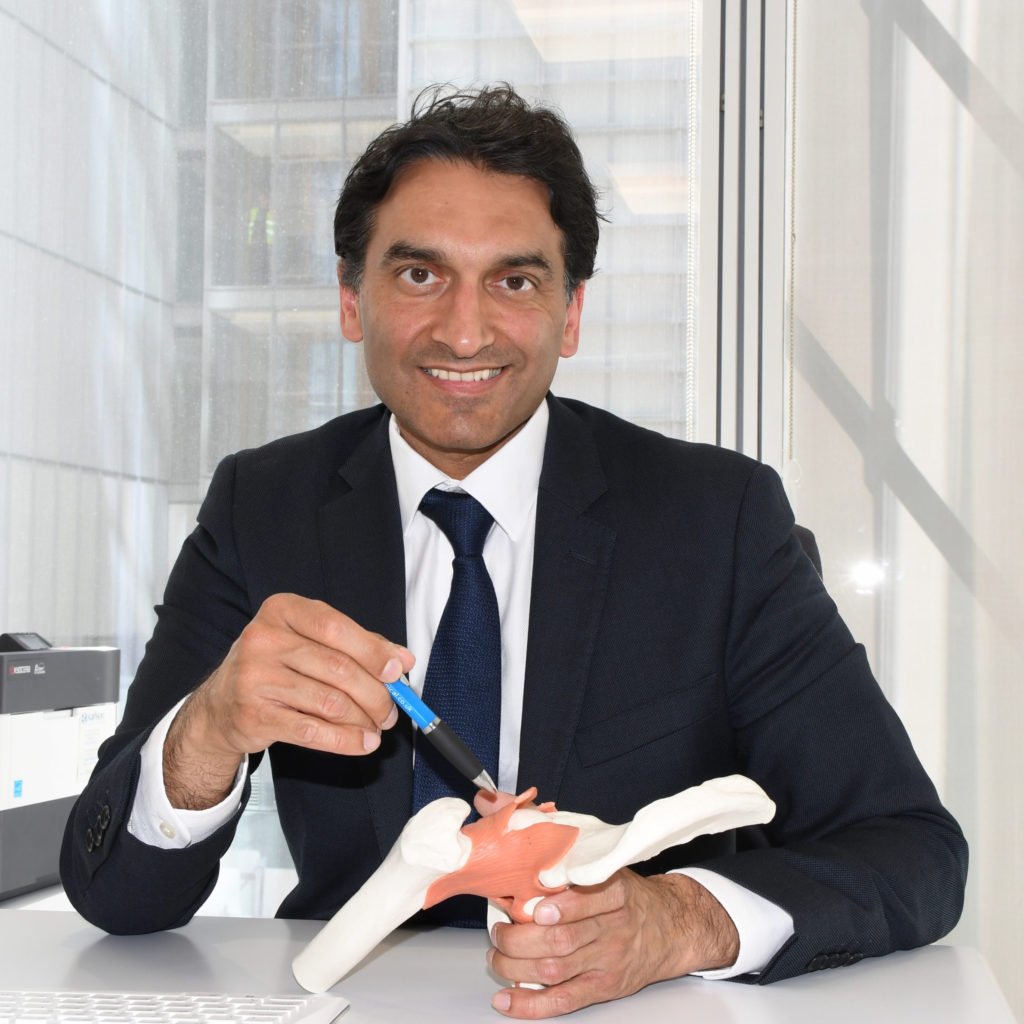ORTHOPAEDIC OPINIONS BLOG
HIP AND KNEE TENNIS INJURIES
By Mr Vipin Asopa, May 2023

Any sport that involves running and quick movements will have the possibility of its players sustaining a knee or hip injury. There are many quick and varied movements that a tennis player will make. This includes turns, stops, jumps and twists; all of which can put a lot of stress on your hips and knees. There are a number of injuries that can therefore occur as a result.
Here are some of the hip and knee injuries that may occur while playing tennis:
Patellofemoral pain syndrome (PFPS)
This may also be known as runner’s knee or chondromalacia patellae.
PFPS is characterised by pain around the kneecap or patella, which worsens with activities that involve bending the knee such as running, jumping, squatting, or sitting for prolonged periods. The pain is usually described as a dull, aching pain or a sharp, stabbing pain that may be aggravated by activities such as climbing stairs, walking downhill or sitting with the knee bent.
The exact cause of PFPS is not known, but it is believed to be a result of a combination of factors, such as overuse, muscle imbalance, abnormal knee alignment, or injury. Treatment for PFPS often includes rest, ice, physical therapy to strengthen the muscles around the knee, and sometimes the use of braces or orthotics. In severe cases, surgery may be necessary.
Meniscus tears
The meniscus is a piece of cartilage that provides cushioning between the bones in your knee joint. Meniscus tears can occur during sudden, twisting movements while playing tennis.
I explain more about meniscus tears in a previous blog which can be found here.
Anterior cruciate ligament (ACL) injuries
The ACL is responsible for providing stability to the knee joint by preventing excessive forward movement of the tibia bone in relation to the femur bone. There are of course many instances throughout a tennis match where a player will make sudden stops or abrupt changes of direction to get to the ball. An injury can occur when the knee is twisted, bent or hyperextended beyond its normal range of motion. Common signs and symptoms of an ACL injury include pain, swelling, and instability of the knee joint.
Treatment for ACL injuries may involve surgery to reconstruct the ligament using a graft from another part of the body or a donor. Physical therapy is also an important part of the rehabilitation process to help restore strength, mobility, and function to the knee. In some cases, conservative management such as rest, ice, compression, and bracing may be recommended for minor or partial tears of the ACL. You can find out more about treatment for ACL injuries here.
IT (iliotibial) band syndrome
Iliotibial band syndrome (ITBS) is a common overuse injury that affects tennis players and also runners, cyclists, and other athletes who engage in repetitive movements that involve the knee. The iliotibial band (IT band) is a thick band of tissue that runs along the outside of the thigh from the hip to the knee.
ITBS occurs when the IT band becomes irritated and inflamed, usually as a result of repetitive stress or overuse. This can cause pain and discomfort on the outside of the knee, as well as tenderness and tightness in the IT band itself. The pain may be most noticeable during activity, especially when the knee is bent. It may improve with rest.
Treatment for ITBS typically involves a combination of rest, ice, stretching, and strengthening exercises. Physical therapy may also be helpful in correcting any underlying muscle imbalances or biomechanical issues that may be contributing to the problem. In some cases, a knee brace or other orthotic devices may be recommended to provide additional support and help relieve pressure on the IT band. In severe cases, corticosteroid injections or surgery may be necessary to alleviate symptoms.
Hip labral tears
A hip labral tear is a tear or damage to the labrum, which is a ring of cartilage that surrounds the hip joint socket. The labrum helps to stabilise the hip joint and provides a cushion between the ball of the femur bone and the socket of the hip bone.
Hip labral tears can occur due to injury, degeneration, or repetitive stress on the hip joint. Common causes include sports-related injuries, overuse injuries, and conditions such as hip dysplasia or femoroacetabular impingement (FAI).
The symptoms of a hip labral tear may include pain in the hip or groin area, clicking or catching sensations, stiffness or limited range of motion in the hip, and a feeling of instability or weakness in the hip joint.
Treatment for a hip labral tear typically involves a combination of rest, physical therapy, and anti-inflammatory medication to relieve pain and inflammation. In some cases, arthroscopic surgery may be necessary to repair or remove the damaged labrum tissue. After surgery, physical therapy is usually recommended to help improve strength, range of motion, and function of the hip joint.
Flare-up of existing hip and knee arthritis
Playing tennis can potentially flare up pre-existing hip and knee arthritis. Tennis involves a lot of repetitive motions, sudden stops, and changes in direction, which can put stress on the hip and knee joints. This can cause pain, swelling, and inflammation in the joints, particularly if there is pre-existing arthritis or other joint-related conditions.
Arthritis is a condition that causes inflammation and damage to the joints, leading to pain, stiffness, and limited mobility. Playing tennis or any other high-impact sport can exacerbate arthritis symptoms and may cause further damage to the joints. This is especially true if the arthritis is already advanced or severe.
If you have pre-existing hip and knee arthritis, it is important to speak with your physical therapist before engaging in any physical activity, including tennis. They can help you determine the appropriate level of activity and provide guidance on how to modify your exercise routine to avoid exacerbating your symptoms. They may also recommend specific exercises or treatments to help alleviate pain and improve joint function.
To find out more, the NHS have listed information on hip and knee arthritis here.
To minimise the risk of injury, it’s important to:
- Warm up properly before playing tennis
- Wear appropriate footwear
- Use proper technique
If you are a regular tennis player, there are also benefits to strength training. You could go to the gym and exercise yourself, or see a Strength and Conditioning coach who can plan your exercises to help strengthen the muscles and ligaments that support your knees and hips.
If an injury occurs
If you experience pain or discomfort in your hips or knees while playing tennis, consider discussing this with your physiotherapist or a medical specialist.

Mr Vipin Asopa, PhD, FRCS (Tr & Orth), MBChB, BSc (hons)
Specialist Consultant Hip and Knee Surgeon in London, with a particular focus on hip pain, knee pain and sports injuries.
Mr Asopa performs numerous surgical procedures including hip and knee joint replacements, arthroscopy, ACL surgery, as well as treating arthritis, ligament injuries, trochanteric pain and more.
To book an appointment with Mr Asopa:
Call: +44 (0) 794 319 1592 | Email: admin@ortho-surgery.uk